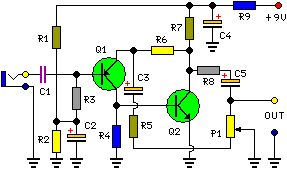- Pump it up: Mp3 Booster
- Bass Booster Circuit
- Audio Booster
- Symmetrical Class A Preamplifier
- Symmetrical Preamplifier Class A
- Modular Class A Buffer preamplifier
- Moduler Preamplifier Circuit Diagram
- Portable Microphone Preamplifier Circuit Schematic
- Stereo Preamplifier With Bass Boost
- Phono Preamplifier
- Modular Preamplifier Switching Center
- Portable Microphone Preamplifier
- Phono Preamplifier
- Electronic Stethoscope
- Speaker Microphone Circuit
Portable Microphone Preamplifier Circuit Schematic
Description
This circuit is mainly intended to provide common home stereo amplifiers with a microphone input. The battery supply is a good compromise: in this manner the input circuit is free from mains low frequency hum pick-up and connection to the amplifier is more simple, due to the absence of mains cable and power supply. Using a stereo microphone the circuit must be doubled. In this case, two separate level controls are better than a dual-ganged stereo potentiometer. Low current drawing (about 2mA) ensures a long battery life.
Circuit diagram:
Parts:
- P1 = 2.2K
- R1 = 100K
- R2 = 100K
- R3 = 100K
- R4 = 8.2K
- R5 = 68R
- R6 = 6.8K
- R7 = 1K
- R8 = 1K
- R9 = 150R
- C1 = 1uF-63V
- C2 = 100uF-25V
- C3 = 100uF-25V
- C4 = 100uF-25V
- C5 = 22uF-25V
- Q1 = BC560
- Q2 = BC550
Circuit Operation:
The circuit is based on a low noise, high gain two stage PNP and NPN transistor amplifier, using DC negative feedback through R6 to stabilize the working conditions quite precisely. Output level is attenuated by P1 but, at the same time, the stage gain is lowered due to the increased value of R5. This unusual connection of P1, helps in obtaining a high headroom input, allowing to cope with a wide range of input sources (0.2 to 200mV RMS for 1V RMS output).
Notes:
- Harmonic distortion is about 0.1% @ 1V RMS output (all frequencies).
- Maximum input voltage (level control cursor set at maximum) = 25mV RMS
- Maximum input voltage (level control cursor set at center position) = 200mV RMS
- Enclosing the circuit in a metal case is highly recommended.
- Simply connect the output of this device to the Aux input of your amplifier through screened cable and suitable connectors.
